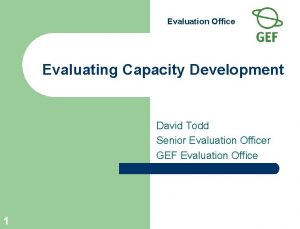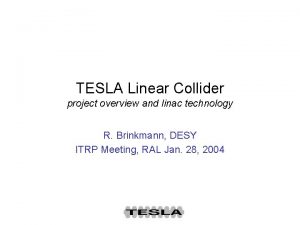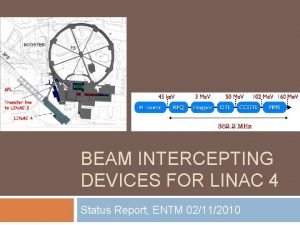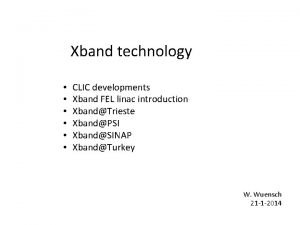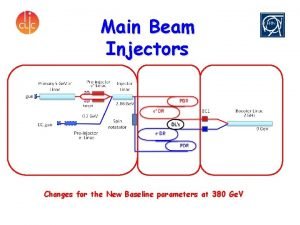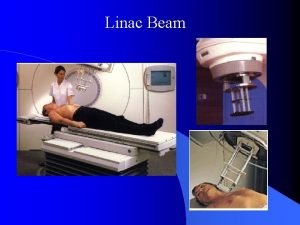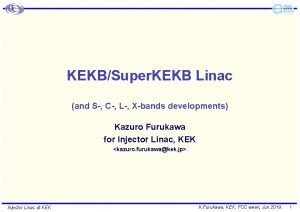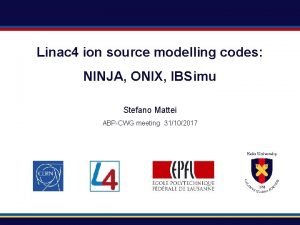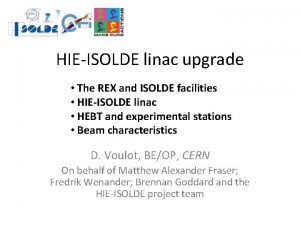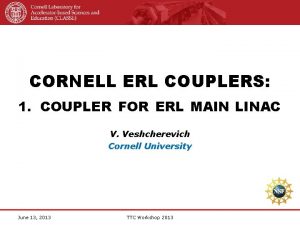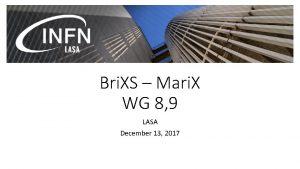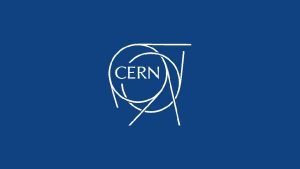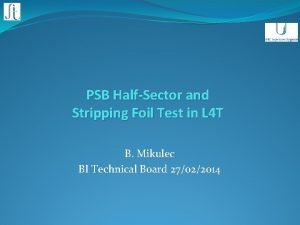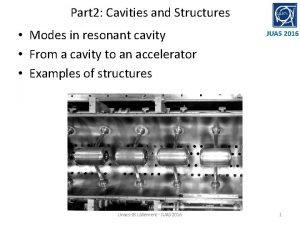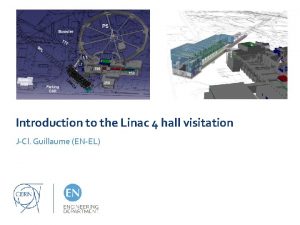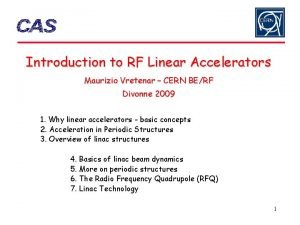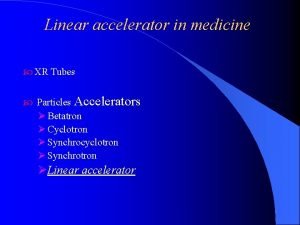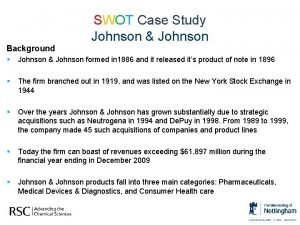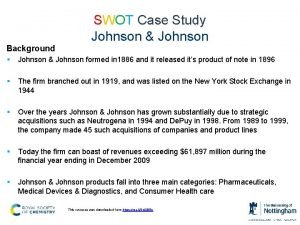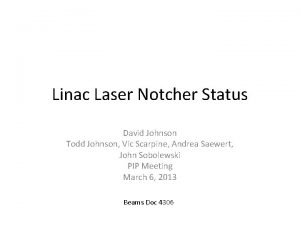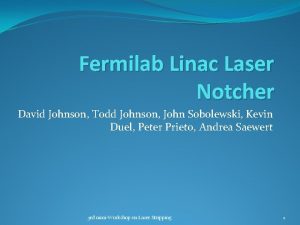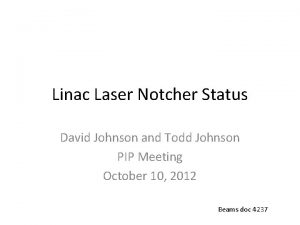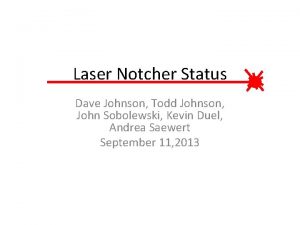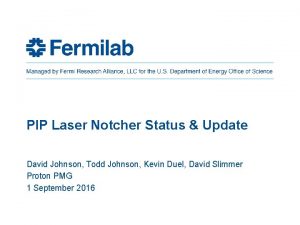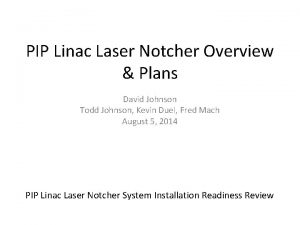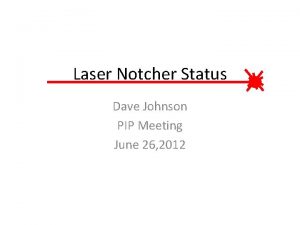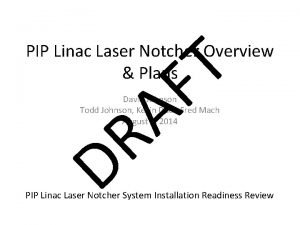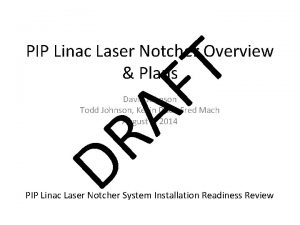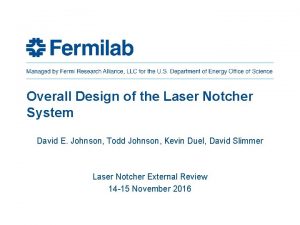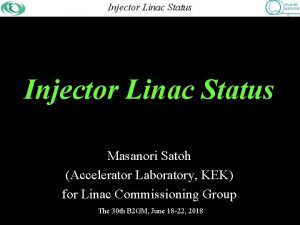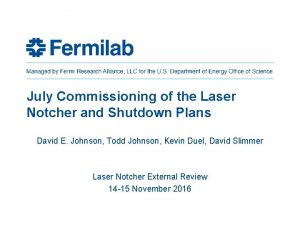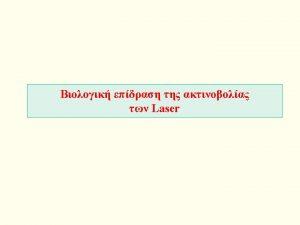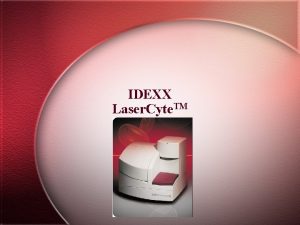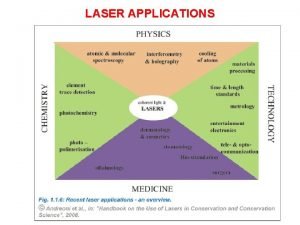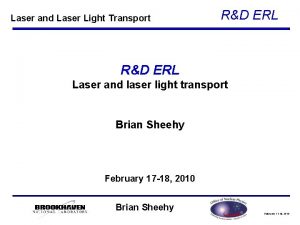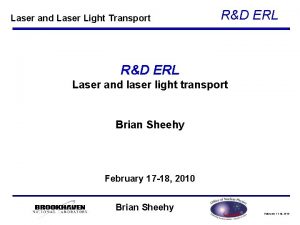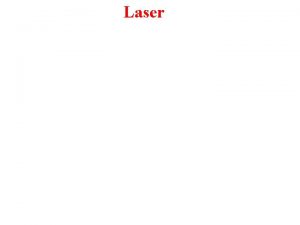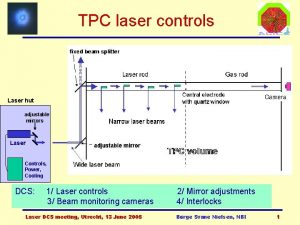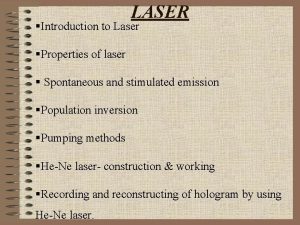Linac Laser Notcher Status David Johnson Todd Johnson

























- Slides: 25

Linac Laser Notcher Status David Johnson, Todd Johnson, Kevin Duel, David Slimmer, Matt Gardner Sreenivas Patil, Jason Tafoya March 2, 2016 PIP weekly meeting Beams doc 5097

• Photonics West • System Layout • Current Status • Fiber splicing complete • Transport enclosure installed for lab testing • Re-starting alignment process • • At this point our main focus is safely working toward full power test Amplifier layout Diode stability Power amp stability • • Dips in power Power output spikes Spikes on reverse power Investigation • Keep-alive frequency • Keep-alive pulse width • Replace single keep alive pulse with burst of 200 MHz at 450 k. Hz • Plans • Pre-amp design

Photonics West • Largest Photonics conference and Exposition in US with over 1200 vendor exhibits • Feb 14 -18, 2016 San Franscisco • Sunday 14 th course on “Improving Laser Reliability, an Introduction” – slides to follow • course on “High-power fiber sources” purchased class notes • Monday – met with Russell Wilcox (LBNL) and discussed our laser notcher laser system particularly our instability and what we did to resolve the issue. • Wednesday- Southampton ORC reunion where I met with several experts in fiber design, amplifier design, and laser design, thanks to KV at Pri. Tel. • Vendors: • Diamond: Met with Swiss Engineers responsible for the E-2000 power solutions connector • Optical Engines: met with Don and Jason to discuss our amplifier design and the issues we have been having. • Northrup Grumman: Met with Jay and Ryan about our DPSS module operation • Many fiber manufactures • Many seed and pump diode manufactures • EOM, laser diode controllers, spectrum analyzers, instrumentation

Photonics West – Improving Laser Reliability, and Introduction • Many/most of the attendees were from industry (Coherent, IPG, Nufern, and Spectra Physics), small businesses, and university (MIT Lincoln Labs) • Seemed to be focused on manufacturing for reliability • Organized the discussion along the following stages • • • Idea/Research phase Design Phase Prototype Phase Manufacturing/Production Phase Support to obsolescence What are reliability considerations for each phase of the laser product life cycle? How to identify the risks to reliability ? How do you estimate laser lifetime? How to utilize best practices in design and manufacturing? How to design qualification tests? How to troubleshoot problems? • Discusses many case studies tips and best practices

• Design for Reliability • Early teamwork makes the difference • System AND component specifications at an early stage are key • From prospective of hardware design- OPTICAL, MECHANICAL, CONTAMINATION, ELECTRONICS, SOFTWARE, AND CHILLERS – need to address each early in design phase • Stray beams, optical weak points, performance margin (system AND component)

Notcher Laser System Layout

External Splice Box & Optical Engines Amplifier Optical Engines Delivery fiber Splice box Pri. Tel Delivery fiber Sreenivas Patil (Pri. Tel) – splice Pti. Tel power amplifier to Optical Engines Amplifier. • Remove old delivery fiber from unit • Splice new delivery fiber inside Pritel unit • Re-install Pri. Tel unit in rack • Re-splice old delivery fiber to connect to power meter to verify splice • Remove old delivery fiber • Create splice in external splice box • Use Spiricon camera to look at light out of Optical Engines Amplifier (un-pumped)

First Light Optical Engines Ø New PCF delivery fiber out of Optical Engines Amplifier – FUD matched to DC-200/40 DZ Yb gain fiber to inherently strip out cladding light ( aperture no required after fiber port) Previous delivery fiber (shown after fiber port) New delivery fiber (shown after fiber port & lens)

Optics Box and Mock-up of Transport Enclosure • Install transport enclosure on temporary support rails Prototype gated integrating sphere / fast phot diode used to measure average power & pulse energy after each amplifier stage Fiber Port – delivery fiber from OE Piezo steering mirrors Optical BPM’s

Diode Stability • Requirements • • • Central wavelength 1064. 14 nm (air) 1064. 43 nm (vac)- Nd: YAG gain peak Spectral bandwidth: looking for about 0. 2 nm FWHM Average Power: limited by modulator to 100 m. W average power Stable output power Stable spectral bandwidth • The instability has greatly improved as • We are running the dipole at 200 m. W and using an air gap attenuator to get the 100 m. W needed for modulator • We are running the TEC at 8 degrees • Always on the lookout for a more stable seed that can be pulsed to increase peak power in the signal pulses

Pri. Tel Amplifier Configuration FP: Pre-Amp Input Pump: 600 m. A 6 um SM Cor. Active YB-401 -PM 4 nm band pass filter ~ 5 m Gain fiber Center 1064 (ASE block) 976 nm pass 1020 -1100 nm block Pump filter Seed 450 u. W 3 W 1064 nm isolator 6 um core External amp 40 m. W Power Monitor & ASD Control PM 2. 1 GHz PD to scope 2 W FP: Power-Amp Input Monitor 976 nm pass 1020 -1100 nm block Pump filter spliced Power Meter FP: SBS Monitor PLMA 10/130 Yb Pump: 7 A (4. 5 W) gain fiber L=3. 5 m Back Panel Fiber port to free space 1064 nm isolator 6 um core Connect to fiber coupled PD into scope Pump dump Fused TC 99/1 3 W 1064 nm isolator 6 um core

• • • Power Amp Stability We need to have a stable input into Optical Engines amplifier. Connect output of Pri. Tel power amplifier to triplet collimator bring into free space Run keep-alive pulses + notch pulses to determine what is required for stable output Direct output into Thorlabs 3 W integrating sphere power meter (measure average power) Beam sampler & PD to monitor pulse structure and peak power of output Photodiode Power meter Fiber port

Dips in output power from Pri. Tel Power Amp OSA: modulator output Gray- spectral bandwidth Blue – power in peak Red – total power

Large forward power spikes OSA: modulator output Gray- spectral bandwidth Blue – power in peak Red – total power • test

Large forward and reverse power spikes • Set up scope to trigger on output PD (set trigger higher than signal) What is causing these spikes in forward & reverse power? Yellow – RF waveform (keep-alive pulse] SBS & Why are we getting SBS? Let’s look into signals in a little more detail Magenta – amplifier output Green – reverse power monitor

Data from 2/5/16. power amp pump 5 A, standard keep-alive pulses. . We see same behavior an pump powers > 4. 5 A Ø Sometimes spikes in both forward and reverse and sometimes spikes only in reverse Ø Always associated with keep-alive pulse Yellow- power amp input monitor Magenta – power amp output monitor Green – power amp reverse power

• With current keep-alive structure (46 ns pulses @ 450 k. Hz) determine maximum pump current for stable operation • Maximum pump current 4. 5 A to give 0. 8 W out of the power amplifier • However, we want to run at 7. 5 Amps • What is required ? • • Frequency higher is better for SBS but not for notch pulses 450 k. Hz Pulse width smaller better but too small can’t pump gain fiber Average power higher is better but we don’t want DC level Peak power good • Investigated each of these options including increasing the increasing input power to pre-amp/power amp with external amplifier

Keep-Alive Frequency • Adjusted keep-alive frequency from 450 k. Hz to 1. 7 MHz Spike in forward power at 450, 500, and 900 k. Hz KA 1. 7 MHz (no spike) but non uniform notch peak pwr

What does ASE and SBS look like SBS spike Broad Spectrum ASE Generated in LMA amplifier

• Create a burst of 200 MHz pulses at 450 k. Hz with AWG to play continuously… disable the current keep-alive • Tried 100 MHz pulses at 450 k. Hz – but still got an “event” • Go back to 200 MHz matches notch pattern NO EVENTS

New Keep-Alive • We found that by using a burst of 200 MHz pulses at 450 k. Hz we can eliminate the large SBS spikes (reverse direction) and large forward spikes. Todd has designed a new hardware keep-alive unit • Runs continuously (crystal osc. ) • Marker pulses from AWG are used to suspend the KA when notch pulses are triggered • KA pulses resume when the marker pulses are absent of 2. 2 us [Hold off]

Plans • GOAL • To safely perform tests of all amplifiers leading to full power test ASAP • Plans • Complete alignment • Install & commission instrumentation ü OBPM’s • Integrating spheres ü Fast photodiodes • Photodiode monitoring circuit ü IR video monitors • • • Re-commission OEA Re-commission DPSS modules Prepare for full power test Dry fit transport & dump enclosure to the installed cavity and support structure Prepare for inert atmosphere in optics box Continue software development

External Amplifier • Used external amplifier between modulator & pre-amp • Increase seed into pre-amp and hence power amp • Amplifiers run further in saturation • Don’t get much more output from power amp. But Reverse power (ASE) reduced dramatically

IL= 0. 3 d. B IL= 0. 5 d. B 400 u. W x 5 W isolator x 30% IL=~. 6 d. B pump F WDM x IL= ~0. 6 d. B Booster x (Do not need both) Mid-stage isolator IL= 2 -3 d. B IL= 0. 3 d. B signal ASE Filter x x F WDM IL= 0. 3 d. B signal IL= 0. 5 d. B x x IL= ~0. 1 d. B x F WDM x New section (contained in existing pre-amp fiber tray) x 5 W isolator x IL= ~0. 7 d. B x LM A x x Pre-amp 140 -160 m. W IL= ~2. 8 d. B x IL= ~1. 0 d. B 5 W isolator IL= ~0. 7 d. B IL= 0. 1 d. B x 5 W isolator x IL= ~0. 7 d. B x 70% 8 -10 m. W Pump 1. 1 A 725 m. W IL= ~0. 6 d. B pump Potential Technique for increasing signal power – pump 2 gain sections with single pump x

r e lic sp to la e lic sp p e lic du m iso p sp er fib e lic sp in Ga e lic DM W e er up l sp co lic 43 m. W 80 m. W 13. 1 m. W 140 m. W 259 m. W 1. 95 W 2. 44 W 10000, 000 pu m A p ta r 10, 000 LM 2 sp e to la iso r te lic sp fil e lic r to la e lic sp AS E e er fib sp in lic 7. 8 m. W iso Ga sp DM 0. 51 m. W 1000, 000 2 x p am e- Pr W r e lic sp to 1, 000 la t ou 100, 000 iso or at od ul M Power along amplfier chain [m. W] EXISTING PRITEL AMPLIFIER 12. 5 d. B 17. 6 d. B 14 d. B 23 d. B 0, 100
 David todd lee
David todd lee Linac
Linac Beam stopper linac
Beam stopper linac Linac
Linac Linac
Linac Linac treatment head
Linac treatment head Linac
Linac Linac
Linac Isis mcr news
Isis mcr news Linac
Linac Linac
Linac Linac
Linac Linac 4
Linac 4 Linac 4
Linac 4 Linac 4
Linac 4 Linac 4
Linac 4 Cern
Cern Linac 4
Linac 4 Flatining
Flatining Swot johnson and johnson
Swot johnson and johnson Johnson and johnson bcg matrix
Johnson and johnson bcg matrix Laurie johnson brad johnson
Laurie johnson brad johnson Ethical decision making
Ethical decision making Johnson and johnson organizational structure
Johnson and johnson organizational structure Johnson and johnson botnet infections
Johnson and johnson botnet infections Johnson and johnson swot analysis
Johnson and johnson swot analysis
